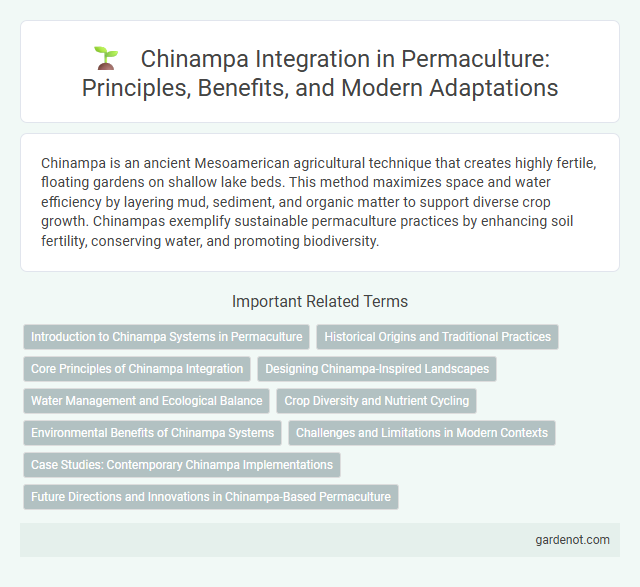Chinampa is an ancient Mesoamerican agricultural technique that creates highly fertile, floating gardens on shallow lake beds. This method maximizes space and water efficiency by layering mud, sediment, and organic matter to support diverse crop growth. Chinampas exemplify sustainable permaculture practices by enhancing soil fertility, conserving water, and promoting biodiversity.
Introduction to Chinampa Systems in Permaculture
Chinampa systems in permaculture represent an ancient form of sustainable agriculture originating from Mesoamerica, characterized by creating highly productive, man-made fertile islands in shallow lake beds. These engineered wetland terraces maximize water efficiency, nutrient cycling, and biodiversity, supporting diverse crops and aquatic life in symbiotic balance. Incorporating chinampa methods enhances soil fertility, water retention, and resilience against climate variability, making it a valuable model for sustainable food production in modern permaculture design.
Historical Origins and Traditional Practices
Chinampa agriculture originated over 1,000 years ago in the Valley of Mexico, primarily developed by the Aztec civilization as a method of intensive crop cultivation on shallow lake beds. These artificial islands were created by layering mud, lake sediment, and decaying vegetation, enabling year-round farming and high yields of staple crops such as maize, beans, and squash. Traditional chinampa practices embraced sustainable water management, nutrient recycling, and biodiversity, forming a resilient agroecosystem that supported large urban populations.
Core Principles of Chinampa Integration
Chinampa agriculture exemplifies the core principles of permaculture integration by creating highly productive, self-sustaining ecosystems on shallow lake beds through the use of organic matter and nutrient cycling. The design maximizes biodiversity by combining aquatic and terrestrial crops, enhancing soil fertility and water management while reducing erosion. This system promotes resilience by mimicking natural wetlands, efficiently using resources, and supporting diverse plant and animal life in a closed-loop environment.
Designing Chinampa-Inspired Landscapes
Chinampa-inspired landscapes integrate raised agricultural beds surrounded by shallow canals, maximizing water efficiency and soil fertility through natural nutrient cycling. Incorporating native aquatic plants and diverse crop species fosters biodiversity and enhances ecosystem resilience in permaculture systems. Strategic placement and layering of vegetation mimic traditional Mesoamerican chinampas, optimizing microclimates and water retention for sustainable food production.
Water Management and Ecological Balance
Chinampa agriculture employs intricate water management systems that utilize canals and raised beds to optimize irrigation and nutrient delivery, promoting sustainable crop growth. These man-made islands enhance ecological balance by supporting biodiversity through a combination of aquatic and terrestrial habitats that regulate microclimates and reduce soil erosion. The integration of native plants and aquatic species in chinampas creates a resilient ecosystem that efficiently recycles water and nutrients while minimizing environmental impact.
Crop Diversity and Nutrient Cycling
Chinampa agriculture exemplifies permaculture principles by integrating diverse crop varieties such as maize, beans, squash, and chili peppers, enhancing ecosystem resilience and productivity. The unique raised garden beds promote efficient nutrient cycling through the decomposition of aquatic plants and organic matter from surrounding canals, enriching the soil naturally. This sustainable practice supports continuous soil fertility and minimizes the need for external fertilizers while fostering a balanced, self-regulating ecosystem.
Environmental Benefits of Chinampa Systems
Chinampa systems enhance biodiversity by creating diverse aquatic and terrestrial habitats that support various plant and animal species. These sustainable agricultural practices improve soil fertility through natural nutrient recycling and reduce the need for synthetic fertilizers. Water management in chinampas minimizes erosion and promotes efficient irrigation, contributing to overall ecosystem health and resilience.
Challenges and Limitations in Modern Contexts
Chinampa agriculture faces challenges in modern contexts due to urbanization, water pollution, and land degradation, which reduce the availability of fertile aquatic environments. Climate change impacts, such as altered rainfall patterns and increased temperatures, threaten the delicate balance of water and soil essential for chinampa cultivation. Efforts to preserve and adapt chinampa systems must address these environmental and socio-economic pressures to maintain their sustainability and productivity.
Case Studies: Contemporary Chinampa Implementations
Contemporary chinampa implementations demonstrate sustainable urban agriculture by integrating ancient Aztec techniques with modern environmental practices, optimizing water use and soil fertility. Case studies from Mexico City reveal increased crop yields and biodiversity in urban spaces, supporting food security and community resilience. These projects highlight effective use of nutrient-rich lake sediments and aquatic plant systems to reduce waste and enhance productivity in limited spaces.
Future Directions and Innovations in Chinampa-Based Permaculture
Emerging innovations in chinampa-based permaculture emphasize integrating smart irrigation technologies and renewable energy sources to enhance water efficiency and sustainability. Research into soil microbiome enhancement and biochar application aims to boost nutrient cycling and carbon sequestration within chinampa systems. Future directions prioritize hybrid designs combining traditional chinampa methods with vertical farming and aquaponics to maximize space utilization and biodiversity.
Chinampa Infographic

 gardenot.com
gardenot.com